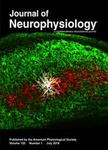版权所有:内蒙古大学图书馆 技术提供:维普资讯• 智图
内蒙古自治区呼和浩特市赛罕区大学西街235号 邮编: 010021

作者机构:Univ Arizona Hlth Sci Ctr Dept Pharmacol Tucson AZ 85724 USA Univ Arizona Hlth Sci Ctr Dept Physiol Tucson AZ 85724 USA
出 版 物:《JOURNAL OF NEUROPHYSIOLOGY》 (神经生理学杂志)
年 卷 期:2000年第83卷第5期
页 面:2610-2615页
核心收录:
学科分类:0710[理学-生物学] 1001[医学-基础医学(可授医学、理学学位)] 07[理学] 071003[理学-生理学]
基 金:NIDA NIH HHS [DA-04248 DA-11823] Funding Source: Medline
主 题:钙/代谢 细胞 培养的 大脑皮质/细胞学 大脑皮质/药物作用 地卓西平马来酸盐/药理学 剂量效应关系 药物 药物协同作用 强啡肽类/药理学 兴奋性氨基酸拮抗剂/药理学 细胞内液/药物作用 细胞内液/代谢 N-甲基天冬氨酸/药理学 神经元/细胞学 神经元/药物作用 神经元/代谢 肽碎片/药理学 受体 N-甲基-D-天冬氨酸/药物作用 受体 阿片样/药物作用 动物 女(雌)性 男(雄)性 大鼠
摘 要:The opioid peptide dynorphin A is known to elicit a number of pathological effects that may result from neuronal excitotoxicity. An up-regulation of this peptide has also been causally related to the dysesthesia associated with inflammation and nerve injury. These effects of dynorphin A are not mediated through opioid receptor activation but can be effectively blocked by pretreatment with N-methyl-D-aspartate (NMDA) receptor antagonists, thus implicating the excitatory amino acid system as a mediator of the actions of dynorphin A and/or its fragments. A direct interaction between dynorphin A and the NMDA receptors has been well established;however the physiological relevance of this interaction remains equivocal. This study examined whether dynorphin A elicits a neuronal excitatory effect that may underlie its activation of the NMDA receptors. Calcium imaging of individual cultured cortical neurons showed that the nonopioid peptide dynorphin A(2-17) induced a time- and dose-dependent increase in intracellular calcium. This excitatory effect of dynorphin A(2-17) was insensitive to (+)- 5-methyl-10,11-dihydro-5H-dibenzo[a, d]-cyclohepten-5,10-imine (MK-801) pretreatment in NMDA-responsive cells. Thus dynorphin A stimulates neuronal cells via a nonopioid, non-NMDA mechanism. This excitatory action of dynorphin A could modulate NMDA receptor activity in vivo by enhancing excitatory neurotransmitter release or by potentiating NMDA receptor function in a calcium-dependent manner. Further characterization of this novel site of action of dynorphin A may provide new insight into the underlying mechanisms of dynorphin excitotoxicity and its pathological role in neuropathy.